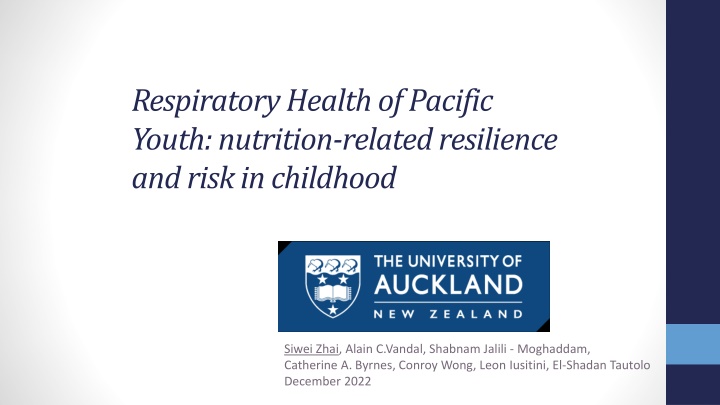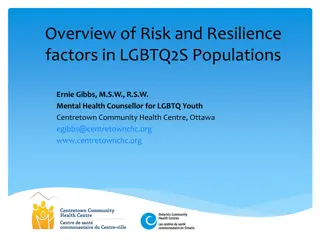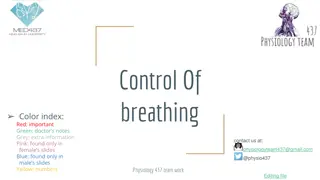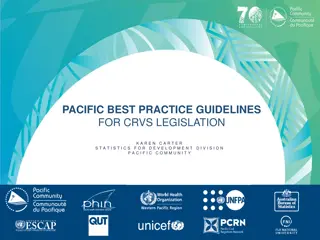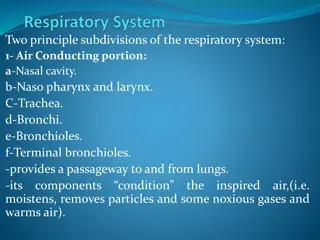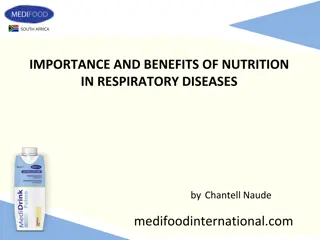Nutrition-Related Resilience and Risk in Pacific Youth Respiratory Health
The research examines the impact of nutrition on respiratory health in Pacific youth, highlighting the high hospitalization rates among this population. Data was collected from the Pacific Islands Families study, focusing on nutrition information gathered at different ages. The primary outcome assessed was the Forced Expiratory Volume in 1 second (FEV1) Z-score at age 18. The study underscores the importance of nutrition in supporting lung growth and healthy lung function in youth.
Download Presentation

Please find below an Image/Link to download the presentation.
The content on the website is provided AS IS for your information and personal use only. It may not be sold, licensed, or shared on other websites without obtaining consent from the author.If you encounter any issues during the download, it is possible that the publisher has removed the file from their server.
You are allowed to download the files provided on this website for personal or commercial use, subject to the condition that they are used lawfully. All files are the property of their respective owners.
The content on the website is provided AS IS for your information and personal use only. It may not be sold, licensed, or shared on other websites without obtaining consent from the author.
E N D
Presentation Transcript
Respiratory Health of Pacific Youth: nutrition-related resilience and risk in childhood Siwei Zhai, Alain C.Vandal, Shabnam Jalili - Moghaddam, Catherine A. Byrnes, Conroy Wong, Leon Iusitini, El-Shadan Tautolo December 2022
Outline Background Data Collection Analysis methods Results Discussions & Conclusion References
Background In New Zealand, 7% of deaths are related to respiratory diseases. (Riley, L., & Cowan, M. 2014) Pacific People have a 2.6 times higher hospitalization rate for respiratory disease than other ethnic groups over all age groups. (Asthma and Respiratory Foundation of New Zealand. 2015) Early pathological studies had concluded that alveolar structure completely forms at two years of age, but more recent magnetic resonance imaging reveals that alveoli continue growing after that and fully develop in early adulthood. (Herring, M. J., Putney, L. F., & Hyde, D. M. 2014; Butler, J. P., Loring, S. H., & Mentzer, S. J. 2012; Narayanan, M., Owers-Bradley, J., ... & Silverman, M. 2012). Therefore, resilience factors such as nutrition may help later lung growth at a certain period.
Data Collection - Pacific Islands Families study (PIF) Pacific Islands Families study (PIFS) consists of the 1,398 individuals born from Pacific Island families in Middlemore Hospital between March and December 2000 Follow-up assessments occurred at birth and age 1, 2, 4, 6, 9, 11, 14,and 18 years 466 from the cohort participated in the respiratory study at 18 years
Data Collection - Nutrition Information Nutrition information was collected at ages 4, 6, 9, and 14 years (Food Frequency Questionnaire) Consumption of each food item was transformed into a daily portion Food items were allocated to 12 food categories at each measurement wave. Fast food/ takeaways , Soft drinks/ energy drinks , Lollies, sweets, chocolate and confectionary , Fruit juices and fruit drinks , Canned fish/ shellfish , Fresh/ frozen fish/ shellfish , Vegetables (Fresh/ frozen/ canned) , Fruit (fresh/ frozen/ canned/ stewed) , Red meat , Chicken , Processed meat products , Bread/ toast/ bread rolls
Major Outcomes Primary outcome: Z-score of Forced Expiratory Volume in 1 second (FEV1) assessed by spirometer at age 18 years. Secondary outcomes: - FEV1 (ml) - Healthy Lung Function defined as the z-score being larger than -1.64.
Analysis Method - Analysis Process Factor analysis Casual Inference Population attributable fractions
Analysis Method - Factor Analysis Exploratory Factor Analysis (EFA) Explored the latent structure of food categories Identified 4 eating patterns: Occasional, Seafood, Fruit and vegetables, and Meat Measurement invariance model A multiple group model from Confirmatory Factor Analysis (CFA) Selected to generate factor loading, which can guarantee that loading were invariant across measurement waves, and then the invariant in nutritional factor scores (NFS) Weighted sum scores (DiStefano, Christine and Zhu, Min and Mindrila, Diana, 2009) Used to compute NFS A coarse method upholds the invariance of the factor scores and can reflect the impact of food category loadings on factors (eating patterns) in the factor scores NFS was scaled to daily portion
Analysis Method - Causal Inference Causal directed acyclical graph Used to identify confounders Was reviewed by experts in the relevant areas Regression model Parametric part: Estimated the causal effect of the exposure on the outcome conditional on the confounders by solving estimating equations. Non-parametric part: Estimated the error distribution by bootstrap method Semi-parametric linear model: Estimated causal effects of NFS on respiratory outcomes Relative risk model: Used to assist in the computation of population attributable fraction Used estimated weights compensating for attrition-induced selection bias
Analysis Method - Population Attributable Fractions (PAF) Estimated the protected fraction of the healthy lung function due to nutrition at the population level The computation of PAF is built on relative risk model (Lloyd, C.J. 1996) ? 1 ? [??(1 ? ???)] ??? = ?? ?=1 ?=1 where ?? is Inverse Probability Weighting (IPW) for the ?? observation, ? is the estimated causal effect, ?? is NFS of the ?? observation.
Results - Population Prevalence in PIFS Healthy Lung Function cohort prevalence was estimated at 90% (95% confidence interval [CI] [0.86,1.00]), smaller than the expected 95%. Healthy Lung Function defined as the z-score being larger than -1.64.
Results - FEV1 Z-score Only the Fruit and vegetables'' eating pattern at 9 years was found to have a statistically significant causal effect on the FEV1 z-score in early adulthood (change in FEV1 z-score: +0.25, 95%CI [0.00,0.43]).
Results - Population Attributable Fraction The proportion of Healthy Lung Function attributable to "Fruit and vegetables" eating pattern at 9 years was estimated at 11% (95%CI [0.00,0.19]).
Results - Population Attributable Fraction We also simulated how the proportion of HLF attributable to "Fruit and vegetables" eating pattern at 9 years changes with nutrition factor score location. This PAF increases monotonically with Nutrition Factor Scores location
Discussions & Conclusion Results suggest a positive impact of consuming more fruit and vegetables during childhood on respiratory health later in life. There is a need to support healthier food environments for Pacific children and access to healthier food choices.
References Riley, L., & Cowan, M. (2014). World Health Organization noncommunicable diseases country profiles. Geneva, Switzerland: WHO Library Cataloguing-in-Publication Data, 156-165. Asthma and Respiratory Foundation of New Zealand. (2015). Te H Ora (the breath of life): national respiratory strategy. Herring, M. J., Putney, L. F., Wyatt, G., Finkbeiner, W. E., & Hyde, D. M. (2014). Growth of alveoli during postnatal development in humans based on stereological estimation. American Journal of Physiology-Lung Cellular and Molecular Physiology, 307(4), L338-L344. Butler, J. P., Loring, S. H., Patz, S., Tsuda, A., Yablonskiy, D. A., & Mentzer, S. J. (2012). Evidence for adult lung growth in humans. New England Journal of Medicine, 367(3), 244-247. DiStefano, Christine and Zhu, Min and Mindrila, Diana (2009). Understanding and using factor scores: Considerations for the applied researcher, Practical Assessment, Research, and Evaluation, vol. 14, no. 1, p. 20, Narayanan, M., Owers-Bradley, J., Beardsmore, C. S., Mada, M., Ball, I., Garipov, R., ... & Silverman, M. (2012). Alveolarization continues during childhood and adolescence: new evidence from helium-3 magnetic resonance. American journal of respiratory and critical care medicine, 185(2), 186-191. Lloyd, C.J. (1996) Estimating attributable response as a function of a continuous risk factor. Biometrika, 83, 563 573
